-
NASA watching waters rise right outside the front door – pt. 1

For the past two centuries, two trends have been steady and clear around the United States. Sea level has been rising, and more people have been moving closer to the coast. As the ocean has warmed, polar ice has melted, and porous landmasses have subsided, global mean sea level has risen by eight inches since 1870. The rate of sea level rise is faster now than at any time in the past 2,000 years, and that rate has doubled in the past two decades. If ice sheets in Greenland and Antarctica continue to melt as quickly as current measurements indicate, those numbers could become twenty-one to twenty-four inches by the 2050s and forty-three to forty-nine inches by the 2080s. About 55 to 60 percent of U.S. citizens live in counties touching the Atlantic or Pacific Ocean, the Gulf of Mexico, or the Great Lakes. A recent study by business and finance leaders found that $66 billion to $106 billion worth of coastal property is likely to sit below sea level by 2050. The nation’s problem is also NASA’s problem, because half to two-thirds of NASA’s infrastructure and assets stand within sixteen feet of sea level.
-
-
Cleaning explosives pollution with plants
Biologists have taken an important step in making it possible to clean millions of hectares of land contaminated by explosives. The researchers have unraveled the mechanism of TNT toxicity in plants, raising the possibility of a new approach to explosives remediation technology. TNT has become an extensive global pollutant over the last 100 years and there are mounting concerns over its toxicity to biological systems.
-
-
What would it take to end California’s drought?
The excitement about a potentially rain-bearing El Niño is building, and hopes for a swift end to California’s ongoing drought are multiplying. At the same time, many of us who have worked extensively on water issues in the state fear the momentum and progress made on much-needed water reforms will be lost. This will be unfortunate, because California’s current water situation offers an invitation to expand how we think about water and drought conditions. A more nuanced perspective about what drought means and our water needs can help continue the momentum on the shifts, such as conservation measures and groundwater management, needed to deal with what is certainly an uncertain future.
-
-
Past strategies for managing droughts are obsolete in a hotter, more densely populated world
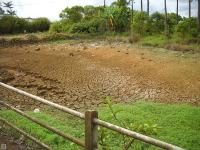
California’s current extreme drought must be a lesson for managing water in a warmer, more densely populated world, experts say. The Golden State has a long history of successfully managing droughts, but strategies from the past century are now obsolete, they assert. The current drought, which began in 2012, is a harbinger of what is to come. Engineering our way around periodic water shortages will no longer work in a hotter, drier world with ceaseless human demands on water supplies. Our ever-increasing thirst for water coupled with poor management, aging infrastructure and worsening climate change is a recipe not just for wells run dry, but for ravaged forests, extinct wildlife, and more droughts. Targeted research and public policies that move beyond a crisis response mentality are critically needed, the experts conclude.
-
-
Smaller cities in developing world unprepared for disaster
While many planners focus on the threat of natural disasters to major metropolises around the world, a new study shows smaller cities are often even less equipped to handle such catastrophes. In India, where his study was focused, the number of people living in such cities grew from 170 to 227 million over the past twenty years. This, however, has not prompted disaster planning experts to focus on how to safeguard these cities from the risk of floods, earthquakes, mudslides, and tidal waves. Many of those threats are even greater now due to climate change.
-
-
Rare but predictable storms could pose big hazards
Researchers at Princeton and MIT have used computer models to show that severe tropical cyclones could hit a number of coastal cities worldwide that are widely seen as unthreatened by such powerful storms.
The researchers call these potentially devastating storms Gray Swans in comparison with the term Black Swan, which has come to mean truly unpredicted events that have a major impact. Gray Swans are highly unlikely, the researchers said, but they can be predicted with a degree of confidence. The researchers examined potential storm hazards for three cities: Tampa, Florida; Cairns, Australia; and Dubai, United Arab Emirates.
-
-
A melting Arctic demands more – not less – research on earth science
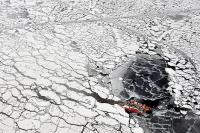
The Arctic is melting rapidly. Who cares? Anyone who is concerned about the rising price of food, lives near the coast, shoveled snow all winter, can’t water their lawn anymore, pays a bigger premium now for property insurance, or enjoys eating seafood. Did we leave anyone out? Apparently so, yet this group of people should care as much as anyone. The House of Representatives earlier this year slashed NASA’s earth sciences research budget, which funds much of the research U.S. scientists do on the Arctic. Scientific research is not a luxury to be indulged. It is an essential contributor to our national well-being, helping us avoid costly mistakes while finding new ways to improve our security, our economy, and our quality of life. Today, Congress is taking us on a course toward an Arctic legacy of myopia, feebleness, and ignorance. Rather than denying the changes that affect us all, they should be steering our national policies toward scientific excellence and vigorous action on challenges such as Arctic meltdown and its impacts. Nowhere is the evidence clearer; never has the need for research been more urgent. We ignore the Arctic at our peril.
-
-
Sea level rise unevenly, which is bad news for some coastal regions
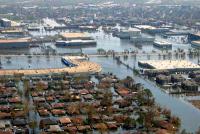
When you fill a sink, the water rises at the same rate to the same height in every corner. This is not the way it works with our rising seas. Tides, winds, and ocean currents play a role in these regional differences, but an increasingly important mover and shaker is the solid Earth itself. Global warming is not just affecting the surface of our world; it is making the Earth move under our feet. These regional differences in sea level change will become even more apparent in the future, as ice sheets melt. For instance, when the Amundsen Sea sector of the West Antarctic Ice Sheet is totally gone, the average global sea level will rise four feet. The East Coast of the United States, however, will see an additional fourteen to fifteen inches above that average.
-
-
Sea-level rise handbook to help land managers, coastal planners, and policy makers
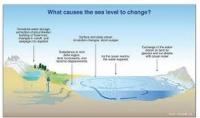
Coastal managers and planners now have access to a new U.S. Geological Survey (USGS) handbook which, for the first time, comprehensively describes the various models used to study and predict sea-level rise and its potential impacts on coasts. The handbook, designed for the benefit of land managers, coastal planners, and policy makers in the United States and around the world, explains many of the contributing factors that account for sea-level change.
-
-
Experts urge negotiators to include water in climate agreement
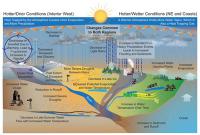
The impact of climate change is felt through water, with flooding, erratic rain patterns, prolonged droughts, and other extreme weather events. Water is also critical for successful climate change mitigation, as many efforts to reduce greenhouse gas emissions depend on reliable access to water resources. World Water Week closed on Friday in Stockholm, with the Stockholm International Water Institute (SIWI) urging climate negotiators to ensure that water is integrated in the global 2015 climate agreement.
-
-
Subjecting countries to “targeted punishments” could tackle climate change
Targeted punishments could provide a path to international climate change cooperation, new research in game theory has found. The research suggests that in situations such as climate change, in which everyone would be better off if everyone cooperated but it may not be individually advantageous to do so, the use of a strategy called “targeted punishment” could help shift society toward global cooperation.
-
-
U.S. coastal communities face increasing risk of compound floods
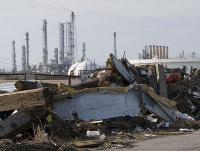
In 2010, 39 percent of the U.S. population lived in coastal communities — a number which is expected to continue to increase in the next five years. The confluence of storm surges and heavy precipitation can bring dangerous flooding to low-lying coastal regions, including major metropolitan areas. A new study of the United States coastline has found the risk of such flooding is higher on the Atlantic coast than the Pacific, and the number of these compound events has increased significantly in many major cities in the past century.
-
-
EU-funded research: Climate change and food safety
The global fresh produce supply chain must take into account climate change in order to ensure food safety, warn EU-funded researchers. This was the key recommendation of the EU-funded VEG-I-TRADE project, which was launched in 2010 to assess the safety of fresh produce in a rapidly evolving context of climate change and expanding international trade.
-
-
Climate change and Hurricane Katrina: what have we learned?
Theory and computer models show that the incidence of the strongest hurricanes — those that come closest to achieving their potential intensity — will increase as the climate warms, and there is some indication that this is happening. Global warming, however, is occurring far too fast for effective human adaptation. Adapting to the myriad changes expected over the next 100 years is such a daunting prospect that otherwise intelligent people rebel against the idea even to the extent of denying the very existence of the risk. This recalcitrance, coupled with rising sea levels, subsiding land, and increased incidence of strong hurricanes, all but guarantees that New Orleans will have moved or have been abandoned by the next century.
-
-
July 2015 the hottest month on record since measurements began in 1880
Global warming continues unabated. The latest NOAA report notes that July 2015 was warmest month ever recorded for the globe – that is, the warmest month since 1880, when temperature measurements were taken in a systematic fashion for the first time. The July globally averaged land surface temperature was 1.73°F (0.96°C) above the twentieth century average. The year-to-date temperature combined across global land and ocean surfaces was 1.53°F (0.85°C) above the twentieth century average. This was the highest for January–July in the 1880–2015 record, surpassing the previous record set in 2010 by 0.16°F (0.09°C).
-
- All
- Regional
- Water
- Biometrics
- Borders/Immig
- Business
- Cybersecurity
- Detection
- Disasters
- Government
- Infrastructure
- International
- Public health
- Public Safety
- Communication interoperabillity
- Emergency services
- Emergency medical services
- Fire
- First response
- IEDs
- Law Enforcement
- Law Enforcement Technology
- Military technology
- Nonlethal weapons
- Nuclear weapons
- Personal protection equipment
- Police
- Notification /alert systems
- Situational awareness
- Weapons systems
- Sci-Tech
- Sector Reports
- Surveillance
- Transportation
Advertising & Marketing: advertise@newswirepubs.com
Editorial: editor@newswirepubs.com
General: info@newswirepubs.com
2010-2011 © News Wire Publications, LLC News Wire Publications, LLC
220 Old Country Road | Suite 200 | Mineola | New York | 11501
Permissions and Policies
Editorial: editor@newswirepubs.com
General: info@newswirepubs.com
2010-2011 © News Wire Publications, LLC News Wire Publications, LLC
220 Old Country Road | Suite 200 | Mineola | New York | 11501
Permissions and Policies
